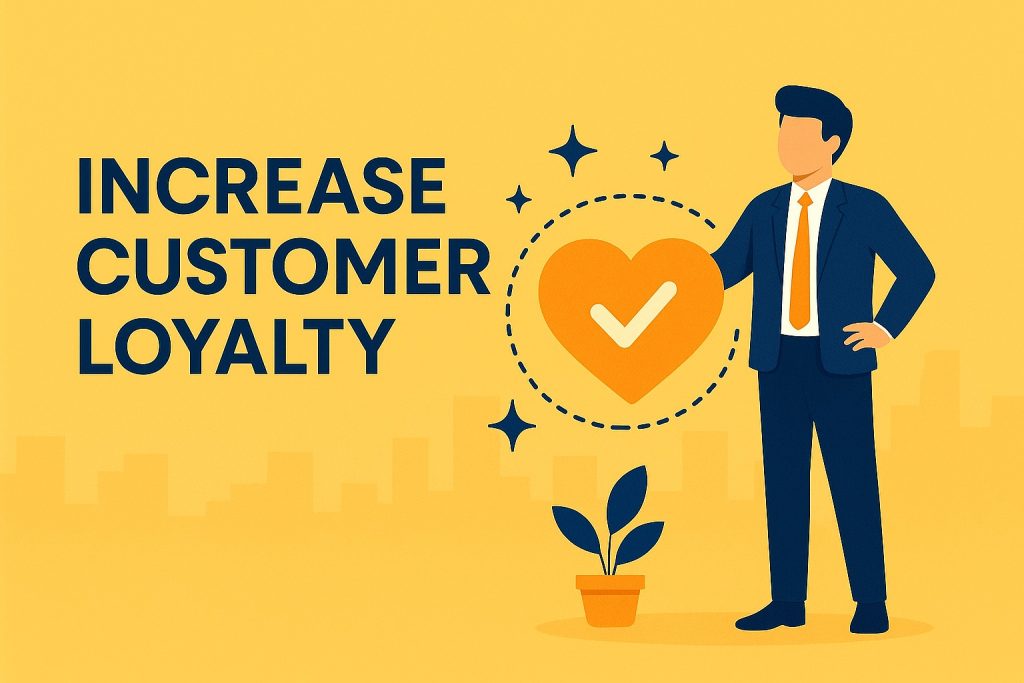Building lasting relationships with customers has become the cornerstone of sustainable business growth. Companies that successfully increase customer loyalty see remarkable returns: loyal customers spend 67% more than new ones and are five times more likely to make repeat purchases.
For marketers and business owners, understanding the mechanics of customer loyalty isn’t just beneficial, it’s essential for long-term success. When customers develop genuine loyalty to your brand, you need to create brand awareness strategy and they become advocates who drive word-of-mouth marketing, provide valuable feedback, and contribute to steady revenue streams.
This comprehensive guide explores proven strategies to increase customer loyalty, from implementing effective loyalty programs to leveraging digital marketing techniques. You’ll discover actionable insights that can transform one-time buyers into lifelong brand champions.
What is Customer Loyalty?
Customer loyalty represents the emotional and behavioral commitment customers develop toward a brand over time. It goes beyond simple repeat purchases to encompass trust, satisfaction, and genuine preference for your products or services over competitors.

Loyal customers demonstrate specific behaviors that distinguish them from casual buyers. They consistently choose your brand despite having other options, recommend your business to friends and family, and remain committed even during challenging times. This loyalty stems from positive experiences, perceived value, and emotional connections formed through consistent brand interactions.
Understanding customer loyalty helps businesses create targeted strategies that nurture these relationships. Companies with strong customer loyalty programs typically see:
- Higher customer lifetime value
- Reduced marketing costs for customer acquisition
- Increased resistance to competitive offers
- More frequent purchases and higher order values
- Valuable customer feedback and product insights
Types of Customer Loyalty Programs
Modern businesses employ various customer loyalty program structures to increase customer loyalty and engagement. Each type offers unique advantages depending on your industry, customer base, and business objectives.
Points-Based Programs reward customers with points for every purchase, which they can later redeem for discounts, products, or exclusive experiences. These programs work exceptionally well for retail businesses and e-commerce platforms because they encourage frequent purchases and create clear value propositions for customers.
Tiered Programs create multiple levels of membership based on customer spending or engagement. As customers advance through tiers, they unlock increasingly valuable benefits. Airlines and hotels have mastered this approach, offering elite status levels that provide upgraded services and exclusive perks.
Cashback Programs return a percentage of purchase amounts to customers, either as account credits or direct refunds. These programs appeal to cost-conscious consumers and work particularly well for credit card companies and online marketplaces.
Community-Based Programs focus on creating exclusive experiences and fostering brand communities. Members gain access to special events, early product releases, or behind-the-scenes of the building good content. This approach works well for lifestyle brands and companies with passionate customer bases.
Why Customer Loyalty Matters for Business Growth
Customer loyalty directly impacts your bottom line through multiple revenue channels and cost savings. Research consistently shows that acquiring new customers costs five to seven times more than retaining existing ones, making loyalty a critical factor in sustainable business growth.
Loyal customers generate predictable revenue streams that help businesses plan and invest confidently. They purchase more frequently, choose premium options, and remain less sensitive to price changes. This stability allows companies to focus resources on product development and innovation rather than constantly chasing new customers.
The ripple effects of customer loyalty extend beyond direct sales. Satisfied loyal customers become brand ambassadors, providing authentic testimonials and referrals that carry more weight than traditional advertising. Their word-of-mouth recommendations drive business organic growth and help build brand credibility in competitive markets.
Key benefits include:
- Reduced marketing costs through lower customer acquisition expenses
- Higher profit margins from repeat purchases and premium selections
- Valuable market insights from engaged customer feedback
- Competitive advantages through differentiated customer experiences
- Brand resilience during economic downturns or market challenges
Customer Loyalty Drives Business Retention
Strong customer loyalty programs create powerful retention mechanisms that keep customers engaged long-term. When customers feel valued and rewarded for their loyalty, they develop emotional connections that transcend transactional relationships.
Retention strategies built around loyalty programs address common reasons why customers leave. These include lack of recognition, poor customer service experiences, or feeling undervalued compared to new customer promotions. Effective loyalty programs directly counter these issues by providing exclusive benefits, personalized attention, and ongoing value recognition.
Data shows that businesses with well-designed loyalty programs retain customers at rates 2.5 times higher than companies without such programs. This retention translates into compound benefits as loyal customers increase their spending over time and become less likely to switch to competitors.
Successful retention through loyalty requires:
- Personalized experiences based on customer preferences and purchase history
- Consistent value delivery through relevant rewards and benefits
- Regular communication that keeps your brand top-of-mind
- Exclusive access to new products, services, or experiences
- Problem resolution that demonstrates commitment to customer satisfaction
Building Emotional Connections with Customers
Emotional loyalty runs deeper than transactional relationships and creates lasting bonds between customers and brands. These connections form when customers feel understood, valued, and aligned with your brand’s values and mission.
Creating emotional connections requires authentic brand storytelling that resonates with your target audience. Share your company’s journey, values, and commitment to customer success. Highlight how your products or services improve customers’ lives beyond basic functionality. This approach helps customers see your brand as a trusted partner rather than just another vendor.
Personalization plays a crucial role in building emotional connections. Use customer data to create tailored experiences, recommendations, and communications that feel relevant and valuable. When customers receive personalized attention, they feel special and appreciated, strengthening their emotional bond with your brand.
Emotional connection strategies include:
- Values-based marketing that aligns with customer beliefs
- Community building through social media and events
- Personalized customer service that goes above and beyond expectations
- Authentic storytelling that humanizes your brand
- Social responsibility initiatives that customers can support
Leveraging Technology to Enhance Loyalty
Modern technology platforms provide sophisticated tools to track customer behavior, personalize experiences, and automate loyalty program management. Customer relationship management (CRM) systems help businesses understand individual customer journeys and create targeted engagement strategies.
Artificial intelligence and machine learning enable predictive analytics that identify customers at risk of churning and suggest personalized retention strategies. These technologies can analyze purchase patterns, engagement levels, and behavioral signals to optimize loyalty program offerings in real-time.
Mobile apps have revolutionized loyalty program accessibility, allowing customers to track rewards, receive personalized offers, and engage with brands seamlessly. Push notifications can deliver timely, relevant messages that drive engagement and purchases without being intrusive.
Technology solutions for loyalty include:
- CRM platforms for comprehensive customer data management
- Marketing automation for personalized communication campaigns
- Mobile apps for convenient program access and engagement
- Analytics tools for measuring program effectiveness and ROI
- AI-powered recommendations for personalized product suggestions
Measuring and Optimizing Loyalty Success
Successful loyalty programs require continuous measurement and optimization to ensure they meet business objectives and customer expectations. Key performance indicators (KPIs) provide insights into program effectiveness and areas for improvement.
Customer lifetime value (CLV) serves as a primary metric for loyalty success, measuring the total revenue a customer generates over their relationship with your business. Track changes in CLV for loyalty program members compared to non-members to quantify program impact.
Engagement metrics reveal how actively customers participate in your loyalty program. Monitor redemption rates, program enrollment numbers, and frequency of interactions to identify trends and opportunities for enhancement. Low engagement might indicate that rewards aren’t compelling enough or the program is too complex.
Essential loyalty metrics include:
- Customer retention rates comparing program members to non-members
- Average order value changes after program enrollment
- Purchase frequency increases among loyal customers
- Net Promoter Score (NPS) for measuring customer advocacy
- Program engagement rates across different customer segments
Future-Proofing Your Loyalty Strategy
Customer expectations continue evolving with technological advances and changing market dynamics. Successful businesses must anticipate these changes and adapt their loyalty strategies accordingly to maintain competitive advantages.
Sustainability and social responsibility increasingly influence customer loyalty decisions. Modern consumers, especially younger demographics, prefer brands that demonstrate environmental consciousness and positive social impact. Incorporating these elements into loyalty programs can strengthen emotional connections and differentiate your brand.
The rise of omnichannel experiences demands seamless loyalty program integration across all customer touchpoints. Customers expect consistent recognition and rewards whether they shop online, in-store, or through mobile apps. This integration requires robust technology infrastructure and coordinated customer experience strategies.
Future loyalty trends include:
- Sustainability-focused rewards that align with environmental values
- Experiential benefits beyond traditional discounts and points
- Partnership ecosystems that expand reward redemption options
- Blockchain technology for secure, transparent loyalty tracking
- Voice and IoT integration for seamless program interactions
Transforming Customers into Brand Champions
Building customer loyalty represents one of the most valuable investments businesses can make for long-term success. The strategies outlined in this guide provide a roadmap for creating meaningful relationships that drive both customer satisfaction and business growth with a impactful brand goals.
Remember that increasing customer loyalty is an ongoing process that requires commitment, resources, and continuous optimization. Start by understanding your customers’ needs and preferences, then design loyalty initiatives that deliver genuine value and emotional connections.
The businesses that thrive will be those that view loyalty not as a program, but as a philosophy that permeates every customer interaction. By implementing these proven strategies and adapting them to your unique market conditions, you’ll build a loyal customer base that drives sustainable growth for years to come.


